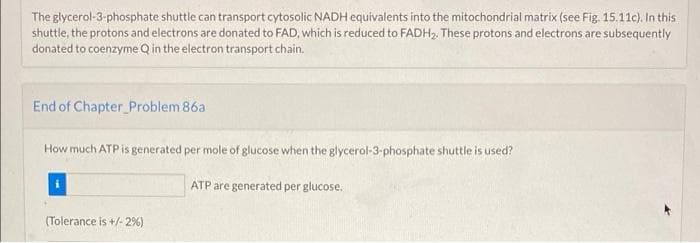End of Chapter Problem 86a How much ATP is generated per mole of glucose when the glycerol-3-phosphate shuttle is used? ATP are generated per glucose. (Tolerance is +/- 2%)
End of Chapter Problem 86a How much ATP is generated per mole of glucose when the glycerol-3-phosphate shuttle is used? ATP are generated per glucose. (Tolerance is +/- 2%)
Biochemistry
6th Edition
ISBN:9781305577206
Author:Reginald H. Garrett, Charles M. Grisham
Publisher:Reginald H. Garrett, Charles M. Grisham
Chapter19: The Tricarboxylic Acid Cycle
Section: Chapter Questions
Problem 16P
Related questions
Question

Transcribed Image Text:The glycerol-3-phosphate shuttle can transport cytosolic NADH equivalents into the mitochondrial matrix (see Fig. 15.11c). In this
shuttle, the protons and electrons are donated to FAD, which is reduced to FADH₂. These protons and electrons are subsequently
donated to coenzyme Q in the electron transport chain.
End of Chapter Problem 86a
How much ATP is generated per mole of glucose when the glycerol-3-phosphate shuttle is used?
(Tolerance is +/- 2%)
ATP are generated per glucose.

Transcribed Image Text:Transport of inorganic phosphate from the intermembrane space to the mitochondrial matrix affects the pH difference across the
inner mitochondrial membrane.
A phosphate ion enters the mitochondrial matrix in antiport with a proton (see Fig. 15.6b). This proton moves in
the same direction as the protons translocated by Complexes I, III, and IV. Thus, the difference in pH between the
mitochondrial matrix and the intermembrane space becomes smaller
Expert Solution
This question has been solved!
Explore an expertly crafted, step-by-step solution for a thorough understanding of key concepts.
Step by step
Solved in 3 steps

Knowledge Booster
Learn more about
Need a deep-dive on the concept behind this application? Look no further. Learn more about this topic, biology and related others by exploring similar questions and additional content below.Recommended textbooks for you

Biochemistry
Biochemistry
ISBN:
9781305577206
Author:
Reginald H. Garrett, Charles M. Grisham
Publisher:
Cengage Learning

Biology (MindTap Course List)
Biology
ISBN:
9781337392938
Author:
Eldra Solomon, Charles Martin, Diana W. Martin, Linda R. Berg
Publisher:
Cengage Learning

Biology: The Dynamic Science (MindTap Course List)
Biology
ISBN:
9781305389892
Author:
Peter J. Russell, Paul E. Hertz, Beverly McMillan
Publisher:
Cengage Learning

Biochemistry
Biochemistry
ISBN:
9781305577206
Author:
Reginald H. Garrett, Charles M. Grisham
Publisher:
Cengage Learning

Biology (MindTap Course List)
Biology
ISBN:
9781337392938
Author:
Eldra Solomon, Charles Martin, Diana W. Martin, Linda R. Berg
Publisher:
Cengage Learning

Biology: The Dynamic Science (MindTap Course List)
Biology
ISBN:
9781305389892
Author:
Peter J. Russell, Paul E. Hertz, Beverly McMillan
Publisher:
Cengage Learning